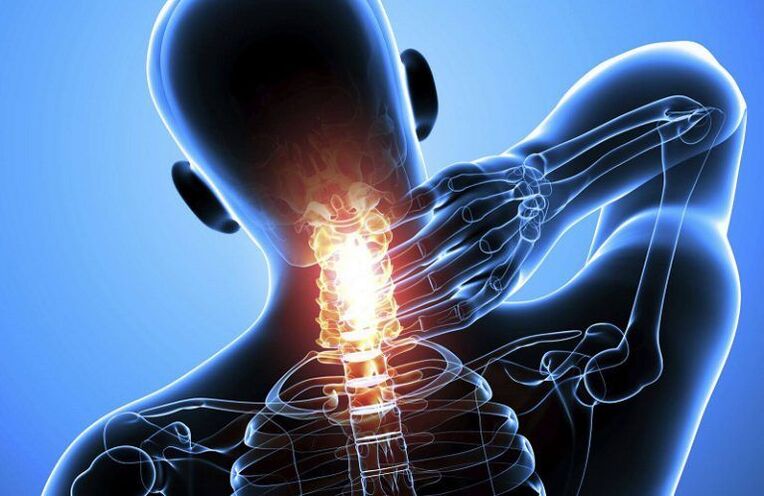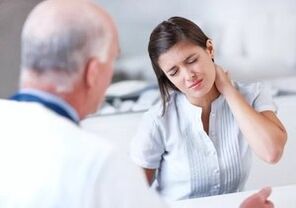With pain in the neck, everyone has encountered it more than once in his or her life. If the back of the neck is sore, then the cause, in most cases, lies in the cervical spine. Let's take a closer look at each disease.
Myositis
With hypothermia and the flu, neck myositis develops - an acute inflammation of the muscles. A person begins to experience severe pain in the neck and shoulders, the temperature rises slightly. On palpation of the painful area, the skin above the muscle is edema, swollen, hot to the touch. When you try to turn your head to the affected part, there is a sharp pain and tension in the neck muscles.

Myositis can manifest against a background of respiratory or viral diseases. Then there is pain in the throat, neck, swollen lymph nodes.
Treatment
Non-steroidal anti-inflammatory drugs will help to quickly and effectively stop inflammation. Various ointments and gels can be applied topically. Here it is necessary to add an important fact about the finalgone - you need to wipe it with a thin layer and can not be washed with water under any circumstances.
You can use semi -alcoholic and warming compresses - with vodka, dilute alcohol or dimexide. Folk remedies also help well: boiled potatoes, rub with honey, apply crushed cabbage leaves.
In addition to the treatment of myositis, the flu is treated - antiviral or antibacterial drugs, vitamins, sprays in the nose and throat. To relieve a sore throat quickly, the spray is a great help - a strong antibacterial and antifungal drug, the effect of which can be felt 20-30 minutes after the start of treatment.
Cervical osteochondrosis
Everyone has heard of the disease, but the reasons for its development remain a mystery.
Predisposing factors are injury, prolonged forced positioning, microtrauma of muscles and tendons during hard physical work, dystrophic processes in the spine, old age, menopause.

With protrusion, instability, hernia in the cervical spine, nerve root compression occurs, blood flow in the vertebral arteries is disrupted, leading to cerebral ischemia.
All symptoms of cervical osteochondrosis are divided into:
- reflex;
- radicular and vascular compression;
- backbone.
More:
- Reflex symptoms occur with prolonged irritation of pathological spinal tissue receptors. Nerve impulses from the affected vertebrae enter the spinal cord, causing changes in the muscles and tissues around it. The muscles of the healthy part take over all functions, forming the stereotype of pathological movement. And the muscles in the affected part correct the displaced vertebra in a certain position, preventing its further curvature. But they also do not provide an opportunity to take a physiological position. If at this time a person does not go to the doctor and chiropractor, muscle atrophy occurs, degenerative changes in vertebral tissue, cervical osteochondrosis is formed. In the future, the progression of the disease causes inflammation and fibrosis of the shoulder girdle muscles, inflammation of the periarticular bag is formed. Reflex symptoms:
- pain along the spinous process - palpation of the neck will cause discomfort, pain, shooting in the vertebrae;
- tension and pain in the back of the neck muscles, aggravated by trying to turn the head or probe;
- cervicalgia - pain or sharp pain in the neck, can subside periodically, giving the person rest. But with loads, long stays in a sitting position (e. g. , during a flight, long journeys in a bus or car), the pain won’t be long in coming. With cervixgia, a person may periodically hear cramps in the neck, feel discomfort and numbness on the skin;
- cervicocranialgia - a feeling of heaviness and aching pain in the neck that spreads to the head. Often, the back of the head suffers - there is a feeling of heaviness, a feeling of "throbbing", numbness, a person wants to support his head with his hands or lean on a hard surface. Periodically there are "hot flashes" - apparently the back of the head and neck burns or freezes. Sleep also suffers - it is intermittent, shallow, the patient wakes up in the morning lethargic, indifferent, tired. The pain can spread throughout the head - photophobia appears, narrowing pain in the temples, neck, eyes, increased blood pressure, nausea and vomiting often occur;
- cervicobrachialgia - pain in the cervical region spreads to the shoulders and arms. There is pain and cramping of the shoulder muscles, stiffness, pain in the shoulder joints, crunchiness, difficulty when trying to lift or take the arm.
- Compression of the roots and ducts of the spinal cord is indicated by vertebral artery syndrome. This is a large complex of various manifestations of vertebral canal compression. There are 3 groups of symptoms that directly indicate the disease:

- throbbing and headaches of a persistent or paroxysmal nature, burning, unbearable. Increased with prolonged uncomfortable position, spreading from occiput to forehead;
- cochleovestibular changes - dizziness, unstable when walking, various sounds in the ears (clicking, ringing, buzzing). Dizziness in patients is constant or paroxysmal, worsening a person's quality of life;
- visual pathology - dark and "flying" in front of the eyes, discomfort and a feeling of "sand", burning, decreased vision.
There are several types of manifestations of vertebral artery syndrome:
Barre -Lieu syndrome - there is pain in the posterior cervical and occipital region, which enters the anterior part of the head - "removes the helmet". It increases at night and after sleep, especially if the person sleeps on an uncomfortable pillow. When turning the head, dizziness and tinnitus appear, becoming dark in the eyes.
Basilar migraine - before a migraine attack, darkness appears in the eyes, flashing black dots, photophobia. The attack begins with severe dizziness, tinnitus, disorders of the articulation of the tongue (a person has difficulty pronouncing words). Violent pain in the back of the neck, back of the head, makes one take over to reduce the attack. At the height of the headache, vomiting appears, in severe cases - fainting.
Cochleovestibular symptoms - aching pain in the back of the neck, throbbing when tilting and turning the head, dizziness, hearing loss and speech comprehension disorders. Often patients are unable to distinguish between whispered speech.
Ophthalmic syndrome - against the background of cervical osteochondrosis, impaired vision. A person experiences rapid eye fatigue when reading, loss of field of vision, conjunctival redness and lacrimation.
Spondylarthrosis
The disease is characterized by "wear and tear" of cartilage with bone growth along the edges of the articular surface. The disease occurs at any age, but most often appears in the elderly. Trauma, inflammation, congenital changes in the joints can lead to the development of spondylarthrosis.
symptoms
The patient is bothered by aching pain in the cervical spine, which is exacerbated by turning and tilting the head. Often a person cannot turn his head completely to the side, attempts to increase range of motion cause back pain. In the supine position, the pain is reduced. In addition to the neck, areas of the spine, knee and hip joints are involved in the process.
As the disease progresses, narrowing of the intervertebral canal occurs in the cervical and lumbar regions. Spondylogenic myelopathy develops - a chronic disease of the spine with weakness of muscle tone and dysfunction of internal organs. Myelopathy causes an increase in pain in a person, reducing the speed of blood flow in the vessels of the neck and head.
Spondyloarthritis
Prolonged pain in the back of the neck, inability to bring the head fully to the chest - symptoms can also speak of rheumatoid arthritis of the spine. The disease develops against the background of polyarthritis - various lesions on the joints.
symptoms
The pain occurs in the back of the neck, spreading to the back of the head, getting stronger when the head is tilted back and forth, turning left and right. A person is unable to move his head fully, the neck muscles are tense and painful. In severe cases, a life -threatening complication develops - bulbar syndrome. Its manifestations are varied and depend on the degree of pinching of the medulla oblongata during atlas subluxation. The patient’s speech is disturbed - it is unclear, slow and the person quickly gets tired of speaking. Swallowing is also disturbed, especially liquid foods. A person chokes, fluid flows out through the nose or corners of the mouth. Impaired cardiac activity - arrhythmias, tachycardia occur.

In children, cervical spondyloarthritis develops as a complication of acute sinusitis - inflammation of the sinuses. The disease is named Grisel torticollis after a French physician. The disease is formed by defects in the articulation of the atlas and axial vertebral teeth.
The symptoms of the disease are specific and allow you to make a diagnosis quickly: the child's head leans towards the source of inflammation and slightly turned in the direction of the healthy.
The treatment of cervical osteochondrosis and spondyloarthritis is similar. Patients require consultation and treatment with a manual therapist. Specialists will quickly and painlessly put the vertebrae in place, eliminating the need for expensive treatment in the clinic. If necessary, every six months or a year, the neurologist at the clinic prescribes a course of medication: these are injections given intramuscularly or intravenously and tablets.
Good help in the treatment of cervical osteochondrosis massage of the collar zone, acupuncture. You can use a self -massage - rub the neck muscles from the back of the head to the shoulders with gentle circular movements. You can’t massage the neck muscles vigorously - you can trigger an increase in arterial and intracranial pressure.
Patients often use applicators - the effect of needle points reduces muscle tension, stimulates blood circulation. It is necessary to use the applicator only after consulting a doctor and making an accurate diagnosis - needles are contraindicated in oncological processes, as they stimulate tumor growth.
In cases of vertebral artery syndrome and cerebral ischemia, nootropic therapy is mandatory: intravenous injection of drugs that stimulate vascular circulation, increase brain oxygenation, reduce dizziness attacks, and tinnitus.
Spinal tuberculosis
With the spread of tuberculosis in the bones and joints, the spine is most often affected. The danger of this disease is in a long period of silence. Tuberculosis does not manifest itself in any way for 2-4 years. As the disease progresses and the vertebral body is destroyed, a feeling of heaviness appears in the neck and shoulders, unexplained pain in the spine without obvious localization.
A person cannot hold his own head for long, he tries to always support it with his hands. Due to severe pain in the neck, the patient avoids turning and tilting his head. When the vertebrae are destroyed, the process spreads to the surrounding tissues, abscesses are formed - abscesses in the capsule. Swelling appears at the back of the neck, with a dense elastic consistency, slowly increasing in size. Abscesses can spread to the pharynx, cough, difficulty swallowing, and sore throat.
Treatment of the tuberculosis process is carried out in specialized tuberculosis dispensaries. Treatment is difficult and lengthy, with many side effects. Strong bacterial preparations for synthetic production are used. The course dose with 2-3 drugs is prescribed. In the process of treatment, monthly blood and urine tests, screening for mycobacterium tuberculosis is carried out. Every two months, the patient undergoes an X-ray examination.
Cancer of the cervical spine
Tumors can occur at any age. Neoplasms can grow from cartilage, bone and nerve tissue. Tumors can be disease independent or be metastatic foci from other organs. Often, metastases in the cervical area give rise to cancer of the breast, prostate, lung and stomach.
Symptoms will increase as the tumor spreads: a person constantly experiences neck pain, difficulties appear when tilting and turning the head. There is weakness, sweating, fatigue. Tumor growth and compression of roots and blood vessels will lead to trembling and weakness of the arm and shoulder girdle, persistent headache, dizziness.
Treatment
apply:
- surgical intervention - complete radical isolation of the tumor in healthy tissue;
- chemotherapy - cytotoxic drugs that slow down the division of tumor cells and prevent further development;
- radiation therapy - effects on tumor cells with ionizing radiation;
- symptomatic treatment - painkillers in the last stages of cancer, narcotic analgesics are most often used.
Spinal cancer is a very dangerous disease, the manifestation of which is often associated with osteochondrosis and late treatment. Therefore, when pain occurs in the cervical spine, it is necessary to do x-rays or magnetic resonance imaging. This will allow you to quickly diagnose and begin appropriate treatment.
In polyclinics, MRIs are very rarely prescribed for financial reasons - but these examinations are performed for a fee at many private centers. It is better to pay a few thousand rubles and protect yourself from treating the disease for a long time, not knowing what the cause of the problem.























